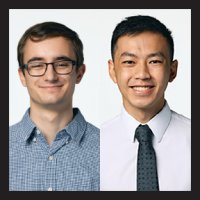
Amidst the fleeting bodies going in and out of Post and Bean Cafe, you may notice two students sitting at a table. A usual sight, sure. Their locked-in gaze to the computer screen is an experience many students that have passed through the University of Massachusetts Amherst have shared. But, it is what lies behind those two students’ screens that sets them apart.
Kieran Tay is a senior studying chemical engineering at UMass Amherst. Hailing from Worcester, Mass, he executes his iCons work with laser-focused precision. Nicholas Sbalbi '22 (Chemical Engineering), while not in the iCons Program, has made invaluable contributions to their goal. The two of them have overseen the Undergraduates Raising Awareness for Anaerobic Digestion (URAAD) project for the last year.
“Our team has developed an Anaerobic Digester (AD) feasibility calculator which allows the user to determine if their geographic location is a possible candidate for the implementation of an anaerobic digester based on factors such as available feedstock, tipping fees, town taxes, and more,” reads their website.
While Kieran and Nick may be seniors, their project will not end upon their graduation. Their research started before them and it will continue after them.
![]() Started by iCons alumni Joshua McGee '21 and Hansen Tjo '21, Kieran and Nick took over the project after they were approached by Hansen and Josh in the winter of their junior year.
Started by iCons alumni Joshua McGee '21 and Hansen Tjo '21, Kieran and Nick took over the project after they were approached by Hansen and Josh in the winter of their junior year.
“I saw it as an opportunity to get involved in something productive,” Nicholas said. Developing the code for an economic calculator to show anaerobic digestion is economically feasible, he subsequently ported it over to a website and developed a template for it.
On Kieran’s side, his work was more physical. “So we built a physical lab-scale biodigester,” he said, “it consists of one flask where you put in blended-up compost and then seal it off to let it run.” With oxygen in it, it’s an aerobic environment at first. After a while, once the oxygen is consumed, it becomes anaerobic digestion.
“When we originally started this, we wanted to turn it into a whole sustainability club. Schedules prevented us from doing that, but we still wanted to create an extracurricular activity that we could pass down,” Kieran said. Just as Kieran and Nicholas were recruited by Hansen and Josh, they have already recruited two younger students to pass the project on to. “We’ll be outlining the future direction for them to effectively carry it on and maintain the goal of spreading awareness of anaerobic digestion.”
It wasn’t always easy finding successors for them to pass down this project to. “ I think we went about it wrong at first,” Kieran said. Their plan was to originally go into each iCons class and discuss research and goals, ask them to apply, and wait to hear. They got about seven applications and arrived at a slow spot in recruitment. “Attrition sets in and people begin to drop out of the recruitment process, we need to find work for people to do before they join.”
When it’s all said and done, the two of them hope to pass on more than just a feasible solution for anaerobic digestion. “Our end goals are not necessarily centered on just anaerobic digestion,” outlined Kieran. “Being able to pass on something that promotes general sustainability is key. I wouldn’t be upset if they look at the research and think AD is unreasonable, but if they take that and convert it to something else while continuing to work on sustainability then of course we would still be satisfied.”
That sort of selflessness and drive for creating something that will have real-world benefits is exactly what iCons strives to endear in its students. “iCons has not taught us a certain approach when attacking this problem,” Kieran concluded. “They’ve given us a project and let us figure out our own ideas and ways to solve a problem.”
While Kieran and Nicholas will be graduating, their impact on URAAD will last far longer. The real-world solutions from a sustainability project are endless, and with continued research performed by Kieran and Nicholas’ successors… the sky is the limit.
Stay Connected